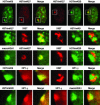Multiple spatially distinct types of facultative heterochromatin on the human inactive X chromosome
- PMID: 15574503
- PMCID: PMC534659
- DOI: 10.1073/pnas.0408021101
Multiple spatially distinct types of facultative heterochromatin on the human inactive X chromosome
Abstract
Heterochromatin is defined classically by condensation throughout the cell cycle, replication in late S phase and gene inactivity. Facultative heterochromatin is of particular interest, because its formation is developmentally regulated as a result of cellular differentiation. The most extensive example of facultative heterochromatin is the mammalian inactive X chromosome (Xi). A variety of histone variants and covalent histone modifications have been implicated in defining the organization of the Xi heterochromatic state, and the features of Xi heterochromatin have been widely interpreted as reflecting a redundant system of gene silencing. However, here we demonstrate that the human Xi is packaged into at least two nonoverlapping heterochromatin types, each characterized by specific Xi features: one defined by the presence of Xi-specific transcript RNA, the histone variant macroH2A, and histone H3 trimethylated at lysine 27 and the other defined by H3 trimethylated at lysine 9, heterochromatin protein 1, and histone H4 trimethylated at lysine 20. Furthermore, regions of the Xi packaged in different heterochromatin types are characterized by different patterns of replication in late S phase. The arrangement of facultative heterochromatin into spatially and temporally distinct domains has implications for both the establishment and maintenance of the Xi and adds a previously unsuspected degree of epigenetic complexity.
Figures




Similar articles
-
Chromatin of the Barr body: histone and non-histone proteins associated with or excluded from the inactive X chromosome.Hum Mol Genet. 2003 Sep 1;12(17):2167-78. doi: 10.1093/hmg/ddg229. Epub 2003 Jul 15. Hum Mol Genet. 2003. PMID: 12915472
-
Histone acetylation controls the inactive X chromosome replication dynamics.Nat Commun. 2011;2:222. doi: 10.1038/ncomms1218. Nat Commun. 2011. PMID: 21364561 Free PMC article.
-
Histone H3 lysine 9 methylation is an epigenetic imprint of facultative heterochromatin.Nat Genet. 2002 Jan;30(1):77-80. doi: 10.1038/ng789. Epub 2001 Dec 10. Nat Genet. 2002. PMID: 11740497
-
Histone modifications and nuclear architecture: a review.J Histochem Cytochem. 2008 Aug;56(8):711-21. doi: 10.1369/jhc.2008.951251. Epub 2008 May 12. J Histochem Cytochem. 2008. PMID: 18474937 Free PMC article. Review.
-
X chromosome inactivation: heterogeneity of heterochromatin.Biochem Cell Biol. 2008 Oct;86(5):370-9. doi: 10.1139/o08-100. Biochem Cell Biol. 2008. PMID: 18923538 Review.
Cited by
-
Gracefully ageing at 50, X-chromosome inactivation becomes a paradigm for RNA and chromatin control.Nat Rev Mol Cell Biol. 2011 Nov 23;12(12):815-26. doi: 10.1038/nrm3231. Nat Rev Mol Cell Biol. 2011. PMID: 22108600 Review.
-
Cytogenetic bands and sharp peaks of Alu underlie large-scale segmental regulation of nuclear genome architecture.Nucleus. 2024 Dec;15(1):2400525. doi: 10.1080/19491034.2024.2400525. Epub 2024 Oct 8. Nucleus. 2024. PMID: 39377317 Free PMC article.
-
Loss of SETDB1 decompacts the inactive X chromosome in part through reactivation of an enhancer in the IL1RAPL1 gene.Epigenetics Chromatin. 2018 Aug 13;11(1):45. doi: 10.1186/s13072-018-0218-9. Epigenetics Chromatin. 2018. PMID: 30103804 Free PMC article.
-
A deletion at the mouse Xist gene exposes trans-effects that alter the heterochromatin of the inactive X chromosome and the replication time and DNA stability of both X chromosomes.Genetics. 2006 Nov;174(3):1115-33. doi: 10.1534/genetics.105.051375. Epub 2006 Sep 15. Genetics. 2006. PMID: 16980402 Free PMC article.
-
DXZ4 chromatin adopts an opposing conformation to that of the surrounding chromosome and acquires a novel inactive X-specific role involving CTCF and antisense transcripts.Genome Res. 2008 Aug;18(8):1259-69. doi: 10.1101/gr.075713.107. Epub 2008 May 2. Genome Res. 2008. PMID: 18456864 Free PMC article.
References
-
- Lyon, M. F. (1961) Nature 190, 372–373. - PubMed
-
- Avner, P. & Heard, E. (2001) Nat. Rev. 2, 59–67. - PubMed
-
- Plath, K., Mlynarczyk-Evans, S., Nusinow, D. A. & Panning, B. (2002) Annu. Rev. Genet. 36, 233–278. - PubMed
-
- Chadwick, B. P. & Willard, H. F. (2001) Hum. Mol. Genet. 10, 1101–1013. - PubMed
-
- Costanzi, C. & Pehrson, J. R. (1998) Nature 393, 599–601. - PubMed
Publication types
MeSH terms
Substances
Grants and funding
LinkOut - more resources
Full Text Sources
Other Literature Sources
Research Materials

